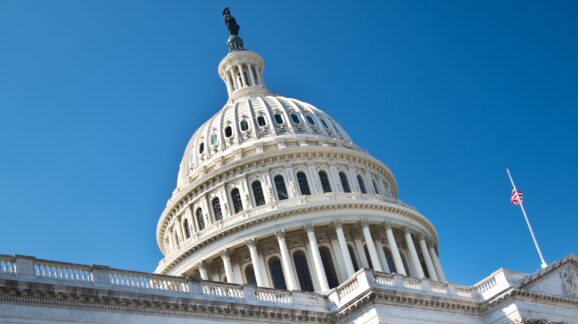New Unfunded Federal Mandates on State and Local Governments Could Spark Regulatory Reform

Photo Credit: Getty
Substantial upticks in final and proposed regulation affecting small business beyond that seen already in the Biden administration appear likelier than not.
A generation ago, regulatory excesses motivated reforms to provide relief to small business, causes and effects that could reemerge, as state and local governments may face a surge in unfunded mandates.
State and local officials’ disaffection during the 1990s with their own budgetary priorities being overridden by federal environmental and other mandates generated demands for reform. Biden’s climate-infused agenda is nothing if not a fresh escalation. All those state and local leaders and subsidized corporations joining Biden on stage to cheer the American Rescue Plan and the subsequent infrastructure, inflation, and technology spending packages may learn the hard way that top-down directives tie down economies, participants, and the general public.
Biden’s insistence that his legislation is “not about handing out a blank check” seems suspect given the firehose of taxpayer dollars. There has been nothing quite like the spending surge of the past few years. The national debt’s upward sweep was evident well before the COVID spiral and resulting mega-bills.
What might be done? As a result of states’ and localities’ now-forgotten headbutts with unfunded mandates, Congress passed the 1995 Unfunded Mandates Reform Act (UMRA) to require the Congressional Budget Office to produce cost estimates of directives affecting state, local, and tribal government spending and consider less costly alternatives for certain actions. The bill was so popular, it was dubbed “S. 1” in the Senate.
But UMRA, which gets surveyed periodically the OMB Report to Congress, on federal regulation, exempts a great deal of intervention from critical analysis.
In the most recent fall Unified Agenda of federal regulatory actions (if past years are predictive, we’ll see a new Agenda the Friday before Christmas Eve), 325 of the 3,777 rules in the pipeline (pre-rule, proposed, final, and recently completed stages) affected local governments. That was an increase of 26 percent over Trump’s final count of 258, of which 46 had been deemed “Deregulatory” in nature. There were 514 affecting state governments under Biden, also a 26 percent increase over Trump’s 409 state actions, of which 72 had been deemed Deregulatory.
These increases happened before the passage this year of the Inflation Act and the CHIPs Act. And the chickens have not come home to roost on much of the rest since COVID.
Even defense reauthorizations will entail regulatory effects rooted in contracting heft, from environmental and social adventurism to potential content regulation.
This brief report represents is a new appeal to monitor funded and unfunded legislative and regulatory mandates affecting governments and large and small businesses alike.
We have a baseline from which to start. As it stands, the Congressional Budget Office reports that since 2006, 190 laws have imposed intergovernmental mandates on states and localities, with 420 mandates within these laws.
Agencies are likely to claim that very few of the rules affecting states and localities (and business) impose unfunded mandates on them. If so, that may underscore the problem of UMRA’s inapplicability to many rules and programs and hasten the aforementioned alliance between small business and small jurisdictions in the pursuit of regulatory reform and streamlining.
Below are some notable completed or pending regulations over the past decade that federal departments and agencies have acknowledged in the Unified Agenda to comprise unfunded mandates.
Department of Agriculture
USDA/FNS: National School Lunch and School Breakfast Programs: Nutrition Standards for All Foods Sold in School, as Required by the Healthy, Hunger-Free Kids Act of 2010
USDA/RBS: Debt Settlement—Community and Business Programs
Department of Health and Human Services
HHS/FDA: Revising the National Drug Code Format and Drug Labeling Barcode Requirements
HHS/FDA: Combinations of Bronchodilators with Expectorants; Cold, Cough, Allergy, Bronchodilator, and Anti-Asthmatic Drug Products for Over-the-Counter Human Use
HHS/CMS: CY 2016 Notice of Benefit and Payment Parameters (CMS-9944-P) (0938-
HHS/FDA: Over-the-Counter Drug Review—Internal Analgesic Products
HHS/CDC: Establishment of Minimum Standards for Birth Certificates
HHS/FDA: Regulations Restricting the Sale and Distribution of Cigarettes and Smokeless Tobacco to Protect Children and Adolescents(
Department of Justice
DOJ/LA: Supplemental Guidelines for Sex Offender Registration and Notification (1105-AB36)DOJ/CRT: Nondiscrimination on the Basis of Disability in State and Local Government Services
Department of Labor
DOL/OSHA: COVID-19 Vaccination and Testing Emergency Temporary Standard Rulemaking
DOL/OSHA: Occupational Exposure to Crystalline Silica
Department of Transportation
DOT/PHMSA: Hazardous Materials: Real-Time Emergency Response Information by Rail
DOT/FHWA: Real-Time System Management Information Program
Architectural and Transportation Barriers Compliance Board
ATBCB: Americans with Disabilities Act Accessibility Guidelines for Transportation Vehicles
Environmental Protection Agency
EPA/OW: National Primary Drinking Water Regulations
EPA/OCSPP: Polychlorinated Biphenyls; Reassessment of Use Authorizations for PCBs in Small Capacitors in Fluorescent Light Ballasts in Schools and Day Cares
EPA/WATER: Effluent Limitations Guidelines and Standards for the Steam Electric Power Generating Point Source Category
EPA/SWER: Revising Underground Storage Tank Regulations—Revisions to Existing Requirements and New Requirements for Secondary Containment and Operator Training
EPA/SWER: Standards for the Management of Coal Combustion Residuals Generated by Commercial Electric Power Producers (Coal Ash)
EPA/AR: Control of Air Pollution from Motor Vehicles: Tier 3 Motor Vehicle Emission and Fuel Standards
EPA/AR: National Emission Standards for Hazardous Air Pollutants for Major Sources: Industrial, Commercial, and Institutional Boilers and Process Heaters; Reconsideration
EPA/AR: National Emission Standards for Hazardous Air Pollutants from Coal- and Oil-Fired Electric Utility Steam Generating Units and Standards of Performance for Electric Utility Steam Generating Units
EPA/AR: National Emission Standards for Hazardous Air Pollutants (NESHAP) from Coal- and Oil-Fired Electric Utility Steam Generating Units and Standards of Performance for Electric Utility Steam Generating Units—Appropriate and Necessary Finding
EPA/AR: NESHAP for Area Sources: Industrial, Commercial, and Institutional Boilers
EPA/AR: NESHAP for Major Sources: Industrial, Commercial, and Institutional Boilers and Process Heaters
EPA/AR: NESHAP: Portland Cement Notice of Reconsideration and New Source Performance Standards for Portland Cement
Nuclear Regulatory Commission
NRC: Revision of Fee Schedules